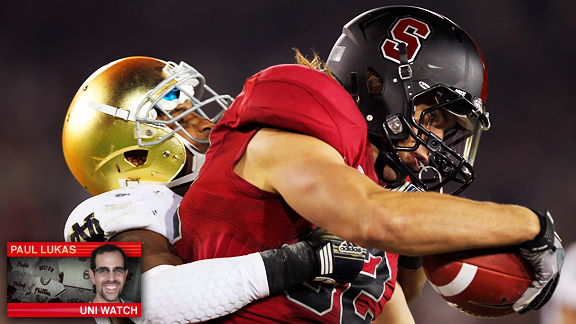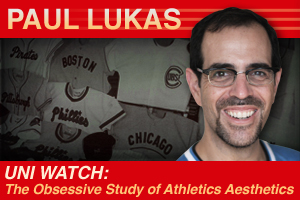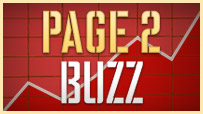Do uniform changes affect broadcasts?
 Getty ImagesFor those who work as football spotters, it's a big deal when jerseys don't have shoulder numbers.
Getty ImagesFor those who work as football spotters, it's a big deal when jerseys don't have shoulder numbers.When Nike unveiled this season's "Pro Combat" college football uniforms in September, Clint Deans didn't like what he saw. But his reasons had nothing to do with the colors or the stripes.
Deans works as a spotter for ESPN's prime-time college football telecasts, and he noticed right away that four of the six Nike designs did not include the small uniform numbers that usually appear on the sleeves, the shoulders, or occasionally the helmets. These "extra" uni numbers are called TV numbers, because they make it easier for fans and broadcasters to identify the players when they're facing off at the line of scrimmage, or whenever they're not facing directly toward or away from the camera. TV numbers are essential for Deans' work as a spotter, so he's frustrated when they're not included in a uniform.
"It makes player identification much more difficult," he says. "I wish they'd think a little more about functionality when they come up with these designs."
TV numbers have been mandatory in the NFL for decades, but they're optional in the NCAA, and some schools don't bother with them. The problem has gotten worse as jersey sleeves have essentially disappeared, leaving less real estate for numbers. Given the choice between putting a number on a player's shoulder or some sort of graphic, many uniform designers would just as soon go with the graphic -- which makes Deans' job that much trickier.
What exactly does a spotter do, anyway? Most fans are familiar with the term but have little sense of what the job entails. So Uni Watch recently chatted with Deans about what he does in the broadcast booth, and about how a uniform design can affect his job.

Uni Watch: How long have you been a spotter with ESPN?
Clint Deans: Since 1992.
UW: How does somebody get into that line of work?
CD: It's mostly a word-of-mouth thing. You don't go to school for it, obviously. In my case, [broadcaster] Brad Nessler was my roommate in college. When he started doing Vikings games in 1988, he called me and said, "Hey, I get to have a spotter." And I said, "Does that mean I get to go to the game for free?" That's how I got started, and I think most other guys have similar stories -- they knew someone.
UW: And what exactly does the job entail?
CD: During the week, as I'm getting ready to work a game, I get all the information on the players for each team, and I put together a set of 11-by-17 boards that are positioned between the two announcers during the broadcast. The boards show everyone who can be on the field, on both sides of the ball, and I use pushpins to indicate who's actually on the field at a particular moment. So the announcers can see that.
Once the game starts, I'm pointing out all the personnel changes to the broadcasters -- letting them know who's coming on and off the field. After a play, obviously, I'm noticing who carried the ball and who made the tackle, but also things like who made a block. Also, I'm looking at the sidelines, seeing if someone's bent over or getting treatment for an injury -- I'll point that out. All of this helps them know what's going on, because of all the distractions they have.
UW: So you're not just a spotter, you're sort of like a prompter.
CD: Pretty much, yeah. It's basically being a third set of eyes for those two guys who are doing the broadcast.
UW: Does every spotter use that same system with the boards and the pins, or is that just your way?
CD: Some guys use cardboard. And someone came up with a program that lets you create the spotting board on a computer and print it out, so some guys use that.
UW: How difficult is it for you if a team doesn't have TV numbers on its uniforms?
CD: Once you've done this for as many years as I have, you can pretty much anticipate what's going to be happening. Here comes their nickel package, here comes their four-wideout set, or whatever, so you already have an idea of who those players are. But you want to confirm it -- you glance at who's in the huddle, then you glance at your board to make sure it matches up. But if there's a number in there that all of a sudden isn't making sense, you try to figure it out. Like, "Huh, I don't have that guy listed on my board" or "Oh, they're using the third guy on the depth chart."
But a lot of times, depending on how they're positioned in the huddle or lining up, you can't really see the front and back. And a lot of times in a pile-up, all you see is body parts. It drives me nuts when I can see a guy, and I'm 99 percent sure I've got him on our boards, but I'm not positive. It's one of those things where you're thinking, If he just had a number on his sleeve, or his shoulder, or his helmet, I'd know for sure.
UW: Is a helmet number just as good as a shoulder or sleeve number, for your purposes?
CD: Yup. Like Alabama, for example. They're awesome -- I can see those numbers just fine. And that's what you want. We like to be ahead of the viewers, you know? That's our goal.
UW: What do you think of the new designs from Nike and the other companies?

a spotter for ESPN, Clint Deans knows his way around the press boxes of the college football world.
CD: I like them -- all the new technology and all, it's cool. But it's frustrating when they don't have those extra numbers. I even emailed them a while back when they came out with that LSU design and said, "You know, if there was just a number on the shoulder or something like that ... " I can't remember the name of the guy I emailed, but I remember I got his name somewhere.
UW: Did you hear back?
CD: Yeah. He said, "Hey, we never thought of that, thanks." And then that was the last I ever heard from him.
UW: What about what Oregon did for the BCS title game, where it put the numbers on the undersleeves?
CD: Yeah, that works. That's great. Heck, even a little number on the back of the helmet helps.
UW: Are there certain teams where you can see the numbers but you have a hard time making them out?
CD: That was the other thing I told the guy at Nike. I said, "You know, these fonts you're using are really cool, but they're so wacky that they're hard to read." Oregon is a really good example -- you look at some of their numbers and you're thinking, "Is that a 1 or a 7? Is that an 8 or a 0?" And again, the Nike guy basically digested all of that and said, "Hmmm, we hadn't thought of that."
UW: Now wait a minute -- of course they'd thought of it! I mean, it's not like they don't know what TV numbers are for, or that they don't think about typeface legibility issues.
CD: You've gotta wonder.
UW: Now, TV numbers are mandatory in the NFL. Have you ever worked NFL games?
CD: Yeah. We do so many college games that the NFL is really a piece of cake. The rosters are so much smaller, there's no double numbers ...
UW: That was my next question! But wait, before we get to that, does it surprise you that the NCAA doesn't require TV numbers like the NFL does?
CD: Yeah, it does, because it makes it harder for us to showcase their product for the fans. I think they've kinda let Nike just take charge of this stuff. It just drives you crazy, because it really makes the job a lot harder, and then that slows down the pace of the broadcast. In a Nike Pro Combat game, you're gonna hear more double-checks from the announcers -- more "Oh, excuse me, that was actually so-and-so." And again, the designs are cool, I like them, but the functionality is a problem.
UW: Now let's talk about double-numbering, where two players on the same team have the same uniform number. That's pretty common in college football, because of the huge rosters. Is that a real challenge for you?
CD: It just adds a bit to the work. But they've got the system pretty well figured out -- I've never seen a situation where they've screwed up and had both guys on the field at the same time. The only tough part is if the two players are really similar in terms of their physical appearance. I'll watch them during warm-ups and maybe I'll write little notes on the boards -- "This guy wears wristbands, this guy doesn't," or whatever. One guy has white socks, the other guy doesn't wear any socks.
UW: What about the name on the back of the jersey? Does that make a difference for you, or are you all about the numbers?
CD: Just the numbers. The only time it matters is in one of those double-number situations. Otherwise, I'm really not looking for the names very often.
UW: When a new uniform is released, do you immediately look to see if they're using TV numbers?
CD: Yup. And then the next thing is whether they're using a traditional block font or one of these techno fonts. And then I just have fun looking at all the new designs and colors, like any fan.
Pretty interesting, right? So when you watch Army wearing its Pro Combat design against Navy on Dec. 8, think about Clint Deans and his fellow spotters. And if anyone from Nike is reading this, Deans asked me to pass along a simple request: From now on, please be sure to include TV numbers on every uniform. Thanks.
How many days until pitchers and catchers?
Seven MLB teams unveiled new uniforms during the past three weeks. In case you missed it, here's the skinny:
• The Padres have a new road uni and have made small tweaks to the rest of their wardrobe. Uni Watch's take: Kinda blah.
• The Marlins have undergone a complete makeover. Uni Watch's take: Yeah, it's sorta goofy-looking, but it's not as though the old design was anything to write home about.
• The Orioles have brought back the cartoon bird cap and made a few other changes. Uni Watch's take: The bird is the word! Nicely done.
• The Mets have eliminated most of the black elements from their ensemble. Uni Watch's take: Halle-freakin'-lujah!
• The Blue Jays have unveiled a modernized version of their original design. Uni Watch's take: This is exactly how to update an old look. Kudos all around.
• The Royals have made some minor adjustments to their road and alternate uniforms. Uni Watch's take: Life-changing? No. But still an upgrade? Yup.
• The Indians have made small tweaks to their home and alternate jerseys. Uni Watch's take: Sure, why not?
All in all, a remarkably sustained run of largely positive uniform news. Take a bow, MLB -- you've set us up for a very good-looking season in 2012.
Follow-up roundup
OK, here we go with one last round of college basketball uniform changes. In addition to the changes that were reported here and here, we also have new uniforms for Belmont, Binghamton, Bowling Green, Bradley, Dayton, East Carolina, Georgia Tech, Iowa State, Kansas State, Loyola Marymount, Saint Louis and Western Carolina. Plus, Dartmouth has added a memorial patch for former player and Big East founder Dave Gavitt.
Meanwhile, remember Uni Watch's recent examination of athletes who wear their wedding rings on the field (or the ice, or the court, as the case might be)? Readers spotted lots of additional examples:
• Former MLB pitcher Sean Green wore his ring on his glove hand.
• No photos, but several readers report that Yankees outfielder Nick Swisher wears his wedding ring on his necklace (just like Rangers pitcher Matt Harrison does).
• Another athlete with his wedding band on a necklace: tennis player Nikolay Davydenko.
• At least two golfers wear their rings on the links: Lucas Glover and Jonathan Byrd.
• Ravens kicker Billy Cundiff appears to wear a band of tape, instead of his actual ring (just like Giants backup QB David Carr does).
• Another athlete who favors the tape ring: soccer player Brian McBride.
• And here's a doozy: You're probably familiar with the famous photo of Chuck Bednarik looming over a flattened Frank Gifford -- it's one of the most iconic shots in NFL history. What you might not know, however, is that Bednarik was wearing his wedding band at the time. Amazing.
Big thanks to all contributors, including Michael Avallone, Ryan Burrows, Dan Clark, Chris Herles, Kyle Ingham, Scott Olman, Steve Ostrowski, Alexander Smith and Thomas Worden.
Paul Lukas will publish his annual Uni Watch holiday gift guide next week. If you liked this column, you'll probably like his daily Uni Watch web site, plus you can follow him on Twitter and Facebook. Want to learn about his Uni Watch Membership Program, be added to his mailing list so you'll always know when a new column has been posted, or just ask him a question? Contact him here.
 |
| • Philbrick: Page 2's Greatest Hits, 2000-2012 |
| • Caple: Fond memories of a road warrior |
| • Snibbe: An illustrated history of Page 2 |
| Philbrick, Gallo: Farewell podcast |
- Sports journalism's foremost uniform reporter
- ESPN.com columnist since 2004
- Also blogs at uni-watch.com
ALSO SEE
- Lukas: Uni Watch on baseball changes
- Uni Watch: College basketball uni additions
- Uni Watch: College basketball uni preview
- Uni Watch: Athletes' wedding rings on the field
- Uni Watch: 2011 NHL goalie gear guide
- Uni Watch: Fan designs Senators jerseys
- Lukas: Rating Nike's new Pro Combat unis
- Uni Watch: College football preview
RECENT ACTIVITY
-
TOOLS
- Contact Us
- Corrections
- Daily Line
- RSS
